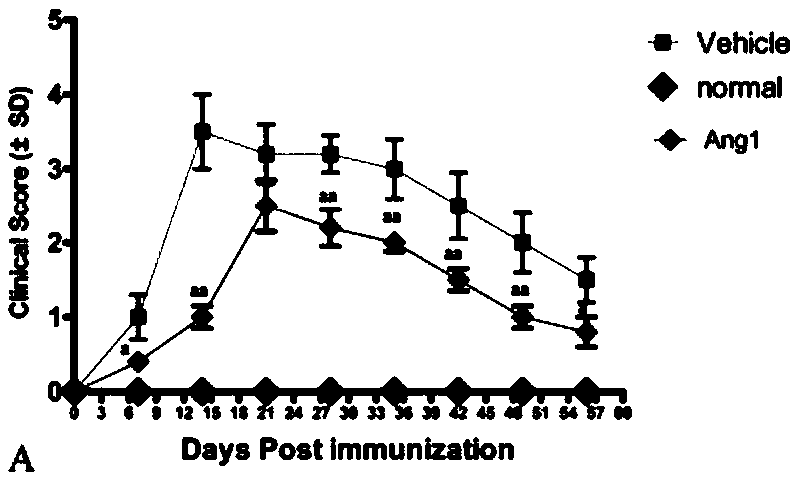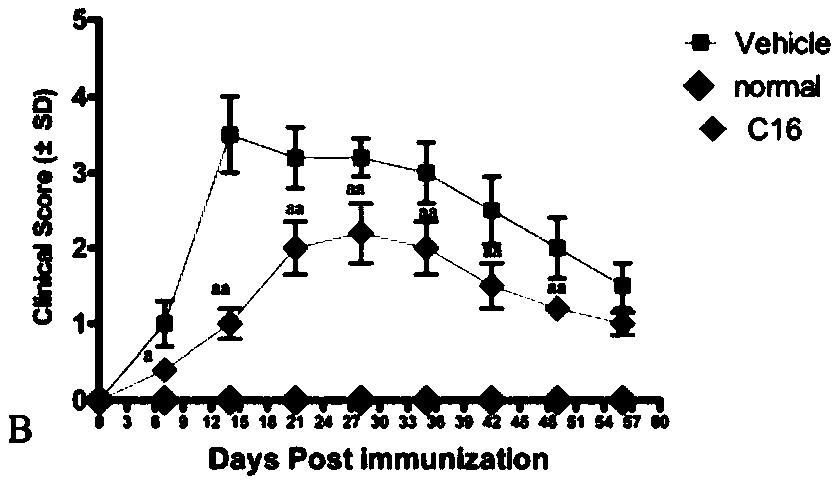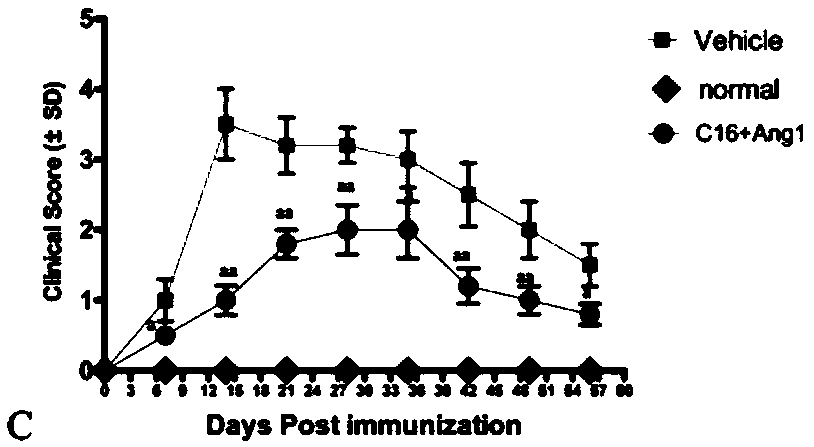Application of C16 polypeptide and angiogenin Ang1 and drug applying C16 polypeptide and angiogenin Ang1
An angiogenin and drug technology, applied in the field of both application and application of drugs, can solve the problems of complex traditional Chinese medicine ingredients, side effects of viral vectors, and few clinical treatment applications, and achieve the effects of reducing loss and good therapeutic effect.
- Summary
- Abstract
- Description
- Claims
- Application Information
AI Technical Summary
Problems solved by technology
Method used
Image
Examples
Embodiment 1
[0098] The corresponding animal model of acute course multiple sclerosis (MS) Experimental Allergic Encephalomyelitis (EAE) was made from guinea pig spinal cord homogenate for antigen-sensitized Lewis rats. The clinical condition score was scored under the condition of double-blind test grouping according to the grading scoring method reported by Reynolds et al. (J Neurocyto1, 2002, 31(6-7):523-36). The criteria are as follows: 0 points, no obvious abnormality; 1 point, weak and flaccid tail; 2 points, slow movement, mild ataxia; 3 points, hind limb weakness; 4 points, hind limb paralysis; 5 points, quadriplegia or death.
[0099] In this example, 100% of the established animal models develop symptoms 9-10 days after sensitization, the course of the disease is unidirectional, and the score reaches 4-5 points.
[0100] From the day of sensitization of the test animals, the rats were divided into 5 groups, 40 rats in each group: positive control (Vehicle) group, negative control...
Embodiment 2
[0104] For the test rats in Example 1, at 2 weeks, the condition of local inflammatory cell infiltration was also evaluated.
[0105] The grading criteria for local inflammatory cell infiltration in the EAE model are as follows: 1 point: inflammatory cell infiltration is limited to perivascular; 2 points: mild inflammatory cell infiltration in the cerebrospinal cord parenchyma (1-10 / section); 3 points: cerebrospinal cord parenchyma Moderate inflammatory cell infiltration (11-100 / section); 4 points: severe inflammatory cell infiltration in the brain and spinal cord parenchyma (100+ / section).
[0106] Statistical results such as figure 2 shown. The local inflammatory cell infiltration in the positive control group (Vehicle) was mostly 3-4 points. When Ang1 and C16 polypeptide were used alone, they had a certain anti-inflammatory effect; but when Ang1 and C16 polypeptide were used in combination, the synergistic anti-inflammatory effect was even stronger Significantly, combine...
Embodiment 3
[0108] Neuromyelitis optica (NMO) is a demyelinating disease involving both the optic nerve and the spinal cord. The main feature is optic neuritis leading to blindness, accompanied by myelitis and paralysis caused by inflammatory lesions in the brain. Unlike multiple sclerosis, a classic demyelinating disease of the central nervous system (CNS), neuromyelitis optica has a low proportion in Western countries and is more common in Asian countries. It is accompanied by transverse or ascending myelitis in the days or weeks before or after it, accounting for 22% of all demyelinating diseases in my country, seriously affecting the health of the people. Histologically, the lesion is characterized by the disintegration of perivascular astrocyte foot processes, and the expression of aquaporin 4 (APQ4) and astrocyte acidic protein (GFAP) levels are severely reduced, suggesting that this is a disease related to multiple Sclerosis is an autoimmune disease with a different pathogenesis, s...
PUM
 Login to View More
Login to View More Abstract
Description
Claims
Application Information
 Login to View More
Login to View More - R&D
- Intellectual Property
- Life Sciences
- Materials
- Tech Scout
- Unparalleled Data Quality
- Higher Quality Content
- 60% Fewer Hallucinations
Browse by: Latest US Patents, China's latest patents, Technical Efficacy Thesaurus, Application Domain, Technology Topic, Popular Technical Reports.
© 2025 PatSnap. All rights reserved.Legal|Privacy policy|Modern Slavery Act Transparency Statement|Sitemap|About US| Contact US: help@patsnap.com



